Pool decks are a great way to add extended living space to your home. When you build a pool deck, you can turn any backyard into an outdoor entertainment venue. Pools aren’t required for pool decks; they’re just the most popular place to install one. Wherever you decide to put your deck, it has certain requirements that must be met to stand up to environmental factors and function properly over the years. This article will go through some of the basics of building a pool deck and share a few helpful tips on making your new deck an enjoyable space.
Pool Decking Materials
It’s important to consider what type of material you want to use for your pool deck. Most people walk on pool decks with bare feet, so a durable, slip-resistant surface is a must. Many different materials can be used to create a pool deck, but some are better suited for the job than others.
Poured Concrete
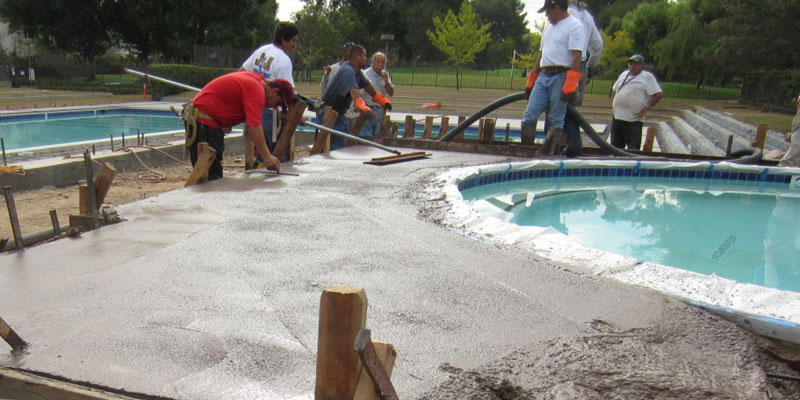
Concrete is a popular choice for pool decks because it’s durable, easy to repair and maintain, and not susceptible to mold or mildew growth. It can also be colored at the time of installation to create vibrant, interesting patterns on the surface of your deck. However, concrete will absorb heat from the sun over time, so this type of deck may not be comfortable during the hotter months.
Pros:
- Durable, slip-resistant surface
- Doesn’t absorb water, so it won’t become slippery when wet
Cons:
- Requires a significant amount of annual upkeep to fix cracks and reseal the surface; complete resurfacing may be required every 6-10 years depending on foot traffic.
Cement Overlay
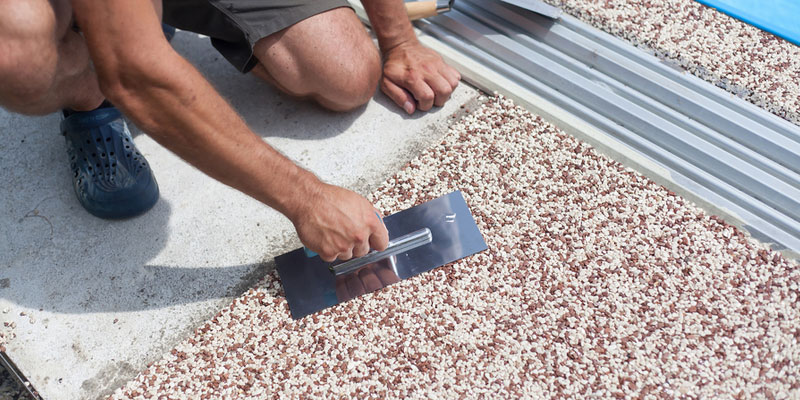
A thin layer of cement is sprayed over an existing surface like wood or concrete to provide new, fresh color and design. This overlay only requires minimal maintenance (like power washing), making it much easier than completely replacing your pool deck material every few years. There are many different decorative options for this type of pool decking that allow you to really make your outside space stand out.
Pros:
- Inexpensive, easy to maintain surface
Cons:
- Can become slippery when wet
- Requires a team of professionals for installation and may not be the best choice if you’re on a tight budget or timeline.
Brick or Stone Pavers
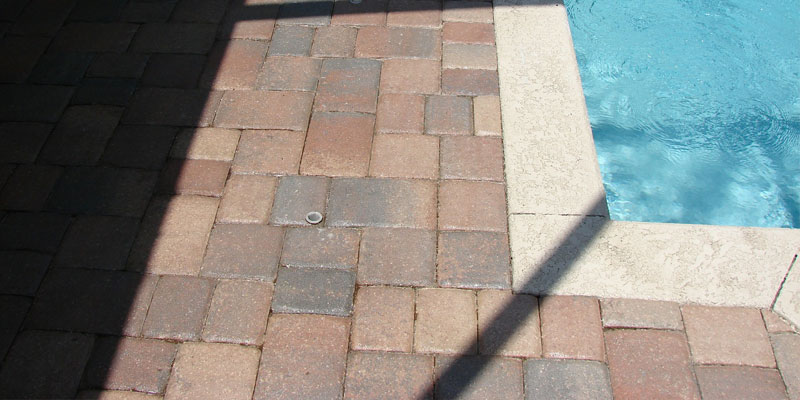
Brick or stone pavers are becoming very popular for pool decking material because they offer many design options. Pavers can be customized to match the color of your house, giving the space a more polished look. They’re easy to clean and maintain, so you won’t have to worry about spending tons of time on upkeep each year. Plus, brick and stone add style and comfort underfoot while protecting against mold and mildew growth. However, some types of pavers may become slippery when wet and require resealing every couple of years to keep them looking their best over time.
Pros:
- Many design options are available
- Durable surface that’s easy to clean and maintain
Cons:
- May become slippery when wet
- May require resealing to keep the surface looking good over time.
Composite Wood
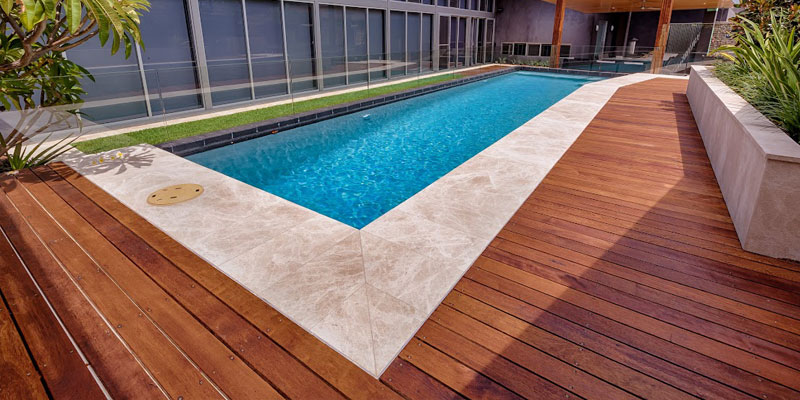
Composite wood is a synthetic material that’s made to look and feel like natural wood. It’s durable, weather-resistant, and doesn’t require much upkeep, making it a popular choice for pool decks. Composite wood is also non-slip, so you won’t have to worry about slipping while enjoying a swim or a cold drink on a hot day. However, composite wood can be more expensive than some of the other materials on this list and may not be as aesthetically pleasing to everyone.
Pros:
- Durable, weather-resistant surface
- Low-maintenance material; does not require painting, staining, or sealing
- Non-slip surface
Cons:
- May be more expensive than some other materials
- May not be as aesthetically pleasing as some people would like.
Stone Tile
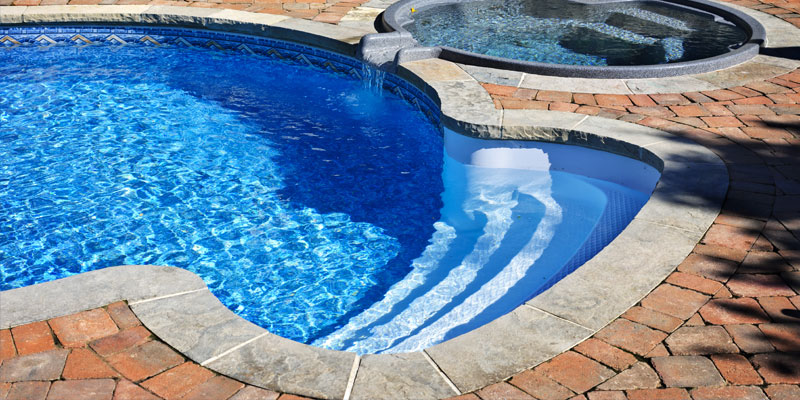
Stone tile is a luxurious option for pool decking and comes in many different shapes, sizes, and colors. It’s durable and easy to clean, making it a good choice for busy families. Stone tile can also be quite expensive, so it may not be the best option if you’re on a tight budget.
Pros:
- Durable surface that’s easy to clean
- Comes in many different shapes, sizes, and colors
- Gives your pool deck a luxurious look
Cons:
- Can be expensive
- May require more maintenance than some of the other materials on this list.
Sandstone Pavers
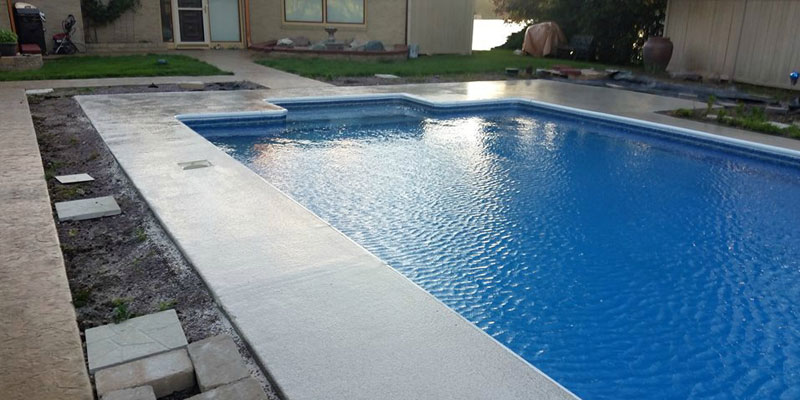
Sandstone pavers are made from natural stone that’s been quarried and then cut into small pieces. This type of paver is available in a variety of colors and can be customized to match your home’s exterior. It’s also durable and easy to clean, making it a good choice for busy families. However, sandstone pavers may become slippery when wet, so you’ll need to take caution when using them around water.
Pros:
- Many different colors are available
- Customizable to match your home’s exterior
- Durable and easy to clean
Cons:
- May become slippery when wet.
Surface Coatings
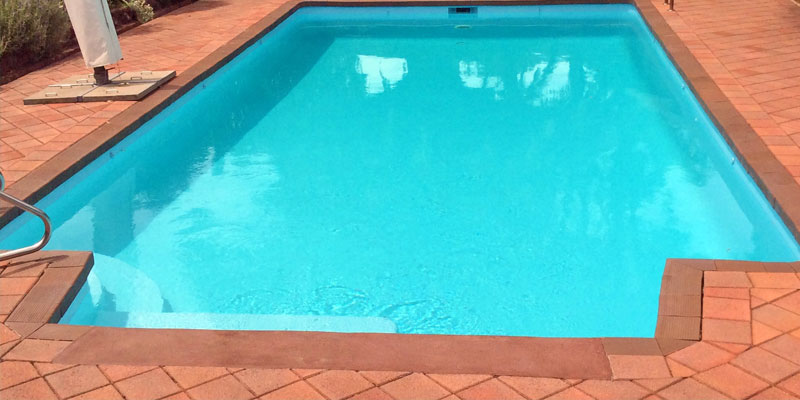
If you’re looking for a low-maintenance, budget-friendly option, then surface coatings may be the best choice for you. This type of material is applied over an existing surface (usually concrete or wood) and comes in a variety of colors and textures. It’s durable, weatherproof, and easy to clean. However, it can also be quite slippery when wet, so you’ll need to take caution when using it around water.
Pros:
- Inexpensive
- Many different colors and textures are available
- Durable, weatherproof surface
Cons:
- Can be quite slippery when wet.
Installation Details
Before you purchase the materials that you’ll use for your pool decking, you need to have a plan in place for how they will be installed. You may choose to have a professional install them, or you may want to do it yourself. Here are some things to keep in mind when it comes time to install your chosen materials:
Pavers and stone tiles must be laid on a bed of sand or grout so they can support the weight of people walking on them and help with drainage.
- Make sure that your paver joints (the spaces between individual pavers) are staggered rather than running side by side. This will add visual interest while also helping water flow through the space more easily.
- Avoid using epoxy grout to install stone tiles. Epoxy is very thick and can cause grout lines to crack or buckle once they’re exposed to water.
- Boiling water must be poured into the joints between sandstone pavers before they’re installed because boiling water will remove air bubbles that may have formed inside the paver surfaces during the manufacturing process. Once these air bubbles are removed, the paver surfaces should form a tight seal against each other when pressure is applied. This ensures that water can drain through them easily.
- Always use safe practices for installation in order to prevent accidents or injuries while you work on your decking project. For example, make sure that children do not work on your decking project with you because there may be hazardous materials involved.
- If you’re interested in installing pool decking yourself, keep in mind that it may be easier to install a surface coating over an existing surface rather than tearing up the existing surface and then redoing it from scratch. What works best for your project may depend on the type of previously installed surface, how much time you have available, and your budget.
Consider a Professional Installation
If you’re not comfortable with installing your own pool decking, or if you don’t have the time to do it yourself, then you may want to consider hiring a professional. Professionals have the experience and knowledge necessary to get the job done quickly and correctly. They’ll also be able to offer advice about the best materials and installation methods for your specific project.
No matter what type of material you choose for your pool decking, be sure to follow all of the installation instructions carefully. This will ensure that your deck is safe and looks great for years to come.
